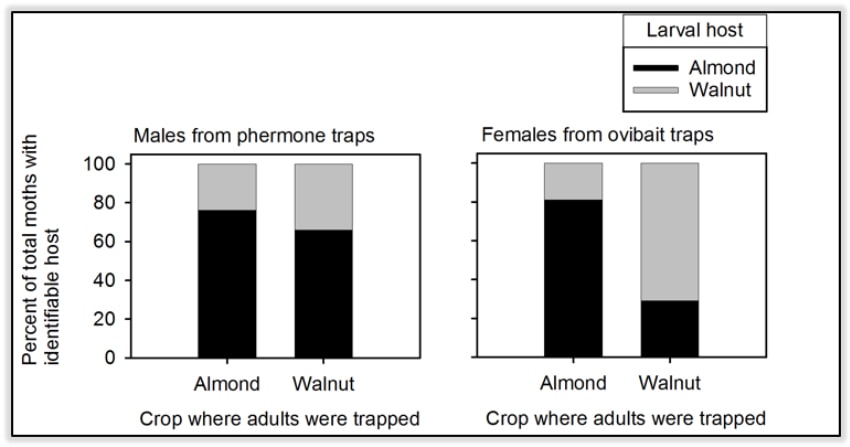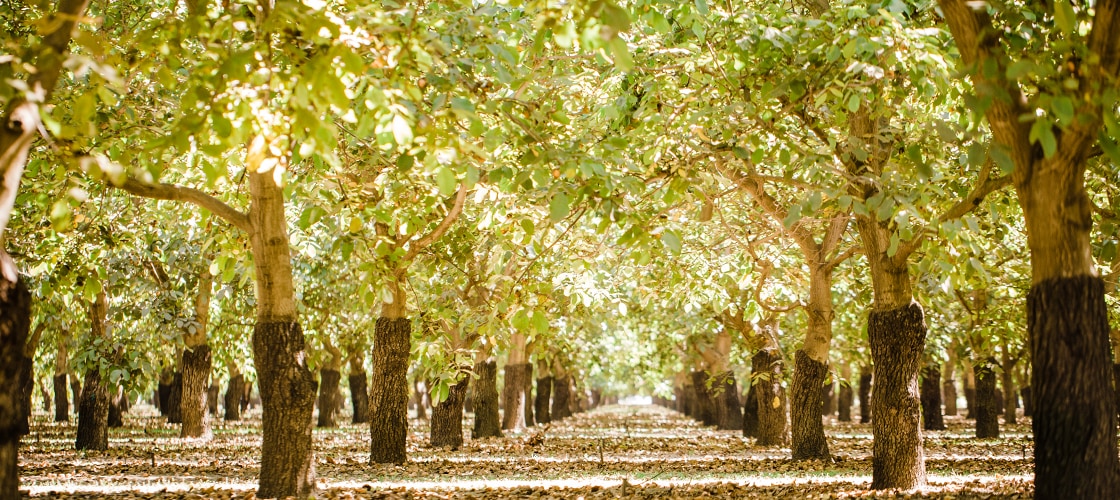[California Walnut Board Online Newsletter, Submitted October 2018]
Emily J. Symmes, PhD
Sacramento Valley Area IPM Advisor
University of California Statewide IPM Program and Cooperative Extension
A local walnut grower phoned me during the first week of September 2018 with the following question, “We’re catching what seems to be a lot of navel orangeworm in traps in a number of our walnut orchards. Is there a treatment threshold?” This really is the golden question for any consultant working in pest management. Integrated Pest Management (IPM) practitioners consider treatment thresholds the “Holy Grail.” In other words, being able to state with a high degree of confidence: If we monitor, trap, or observe “above X” number of pests, applying a treatment is necessary to prevent economic damage. If “below X” number of pests, no treatment is needed.
Unfortunately, I could not answer with certainty the grower’s treatment threshold question. However, I was able to provide new insights and considerations resulting from recent projects funded by the California Walnut Board. A team of University of California and USDA researchers, in collaboration with industry, growers, and PCA partners, continues to gather and analyze data to better address NOW management in walnuts. Some significant findings of ongoing NOW monitoring and decision-support research are summarized below.
A study initiated in 2016 compared the performance of different pheromone lures in trapping adult male NOW in almond orchards in three areas of the state (representing north, central, and southern Central Valley walnut growing regions). In this study, we compared the numbers of males caught in traps baited with one of four pheromone lure formulations to male capture in traps baited with live, calling females. Of these, Trécé Pherocon® NOW L2 and Suterra NOW Biolure® performed the most consistently.
In 2017, we initiated a study to further understand the movement of NOW between walnut orchards in proximity to alternate host crops (almonds in this study), and the significance of trap counts when monitoring adult male NOW and adult female NOW in these landscapes. Adult male sticky traps were baited with pheromone lures (Trécé Pherocon® NOW L2), and adult female sticky traps were baited with ovipositional bait bag lures (Peterson Trap Co.). These “ovibait lures” consist of ground pistachio and almond culls in a mesh pouch, and have been shown to preferentially attract and capture gravid females (those that have been mated and are ready to lay eggs).
In this study, adult male and female NOW caught in their respective traps in adjacent almond and walnut orchards were dissected and their gut contents analyzed, allowing us to determine whether larvae that gave rise to those adults had developed in walnuts or in almonds. The results of the first year of this research indicated that females in ovibait traps were more likely to be trapped as adults in the crop in which they developed as larvae, whereas males were caught in higher abundance season-long during each flight and appear to move between adjacent crops more readily (Figure 1). This is consistent with the hypotheses that NOW pheromone traps (for males) have a greater trapping radius than ovipositional bait traps (for females), and that female trap counts may provide more block-specific data and a greater association with ultimate crop damage. Evidence of the second phenomenon has also been observed in almonds. (Rosenheim et al., December 2017, Journal of Economic Entomology)
In a practical sense, what do results of this research mean for monitoring NOW in walnut orchards as a decision-support tool for deciding whether to apply husk split treatments? Utilizing a combination of adult trap types may provide the best two-pronged information: (1) pheromone traps for male NOW to inform season-long activity (e.g., population detection, flight patterns, relative abundance), and (2) ovipositional bait bag traps for female NOW to inform site-specific pressure and damage potential.
Research into best practices for monitoring NOW, establishing treatment thresholds, and evaluating options for population reduction are ongoing. Stay tuned for future research updates and plan to attend your local University of California Cooperative Extension meetings to keep up-to-date on the latest findings.

Figure 1. Association of adult NOW trap capture and larval development host in adjacent walnut and almond orchards (from Burks, Symmes, and Rijal. 2017 Walnut Research Reports).

